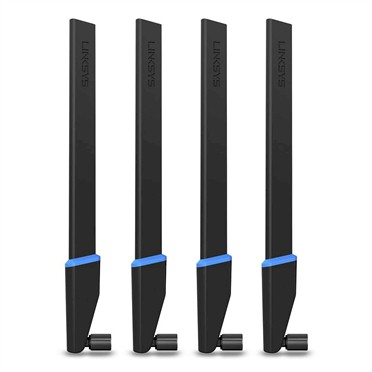
| At a glance | |
|---|---|
| Product | Linksys High-Gain Antennas (WRT004ANT) [Website] |
| Summary | Dual-band “high-gains” antennas aimed at expanding wireless coverage |
| Pros | • Come in a nice package |
| Cons | • Narrow vertical beamwidth provides expanded coverage on same floor only • No minimum specified gain |
Typical Price: $0 Buy From Amazon
Introduction
In discussions of how to improve wireless range and coverage, the subject of higher-gain antennas usually comes up. Higher-gain antennas seem to be a better choice than looking for routers with higher transmit power because antenna gain applies to both transmit and receive signals. This is because Wi-Fi is a two-way communications medium, being able to "shout louder" (amp up router transmit power) helps only if the router can hear the faint reply of weaker client devices.
Linksys’ High-Gain Antenna comes in packages of two (WRT002ANT) and four (WRT004ANT) that have MSRPs of $79.99 and $99.99, respectively. But Linksys knows that’s a tough sell, because they are selling them for $59.99 and $129.99 on the Linksys website.
Linksys sent the four-pack as the review sample, with all four antennas tucked into a plastic tray but no documentation other than that printed on the box. The product and support pages contain no user manual, but do have a link to a Getting to know the Linksys WRT High Gain Antennas article. The feature bullets and specs below come from that page.
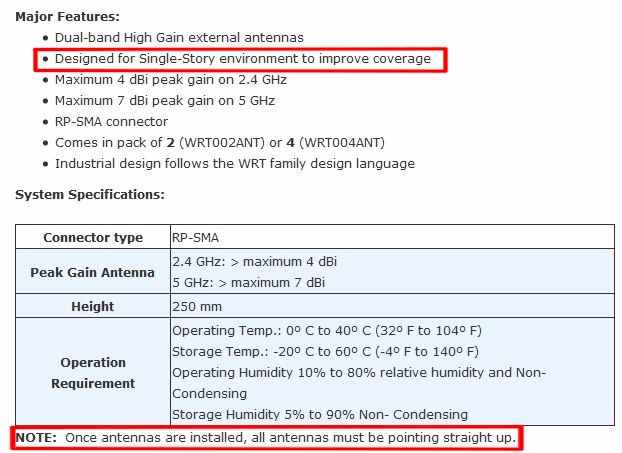
Linksys Hi Gain Antenna specs
I highlighted two key points above that buyers who only read the product box would not be aware of. The reason for the limitations makes more sense once you read the spec shown below, found only on the product page.
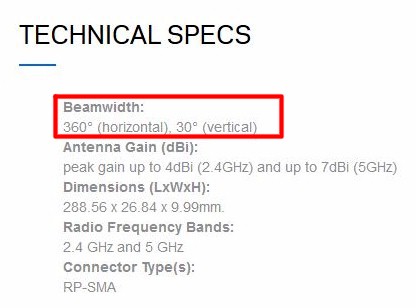
Linksys Hi Gain Antenna specs
The thing about antenna gain is that it comes at the expense of beamwidth. The only antenna that radiates (or receives) in all directions equally is the isotropic, or ideal, which doesn’t exist. Its radiation pattern looks like a perfect sphere, i.e. equal power in all directions.
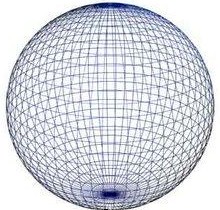
Isotropic antenna pattern
The antenna pattern of the half-wave dipole "omnidirectional" antenna that is used by many routers is different when viewed from the top (azimuth plane) and side (elevation plane). From the top, it looks (or should look) like a perfect circle. But from the side it looks more like a donut.
The example patterns below from a Cisco Antenna Patterns and Their Meaning whitepaper, illustrate this clearly. The pattern on the left is typical of the garden variety half-wave stick or "rubber-duck" dipole. Its ideal gain should be 2.2 dBi (you’ll also see 2.1 / 2.14 / 2.15 used—they’re all the same).
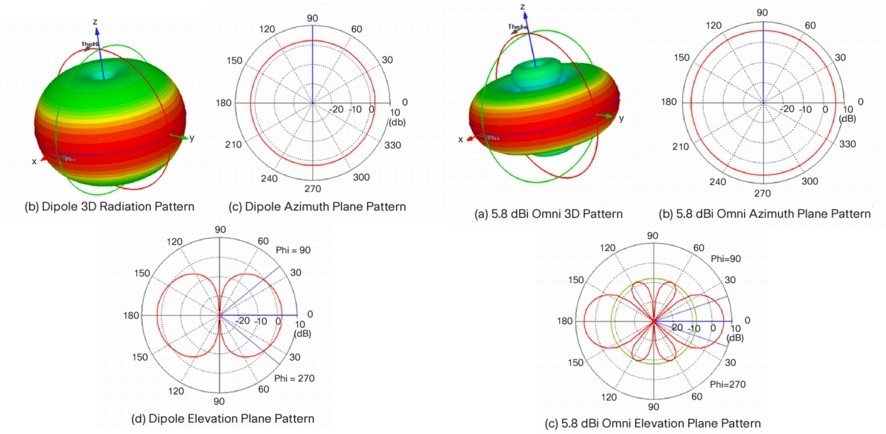
Half-wave dipole patterns (Courtesy Cisco)
The pattern on the right shows a "high(er)" gain dipole, with a gain of 5.8 dBi. The azimuth plane is again a circle, just like the dipole. But the elevation plane is flatter, i.e. it has a narrower beamwidth. An ideal half-wave dipole has a beamwidth of 78°.
Note that dual-band antenna patterns (and gains) will be different for each band. For the Linksys High-Gain, the spec is up to 4 dBi in 2.4 GHz and up to 7 dBi in 5 GHz. Take note of the "up to"; there is no minimum or even typical gain specified. So the antennas could have no additional gain over 2.2 dBi and still be within spec!
So, long story short, since Linksys’ High Gain antenna has a 30° beamwidth—about half that of a plain ol’ dipole—it might actually provide worse coverage to floors above or below it, depending on the effective angle between router and device. Hence, the "designed for single story environment" caveat.
The Antenna
The photo below shows the High-Gain is almost 2 1/2 times the size of the stock WRT antenna.

High Gain & Normal WRT antennas
If you have your WRT1900AC on a shelf, you better check the available height before you order them. The 288.56 mm length spec above translates to 11.4 inches for the metrically impaired.
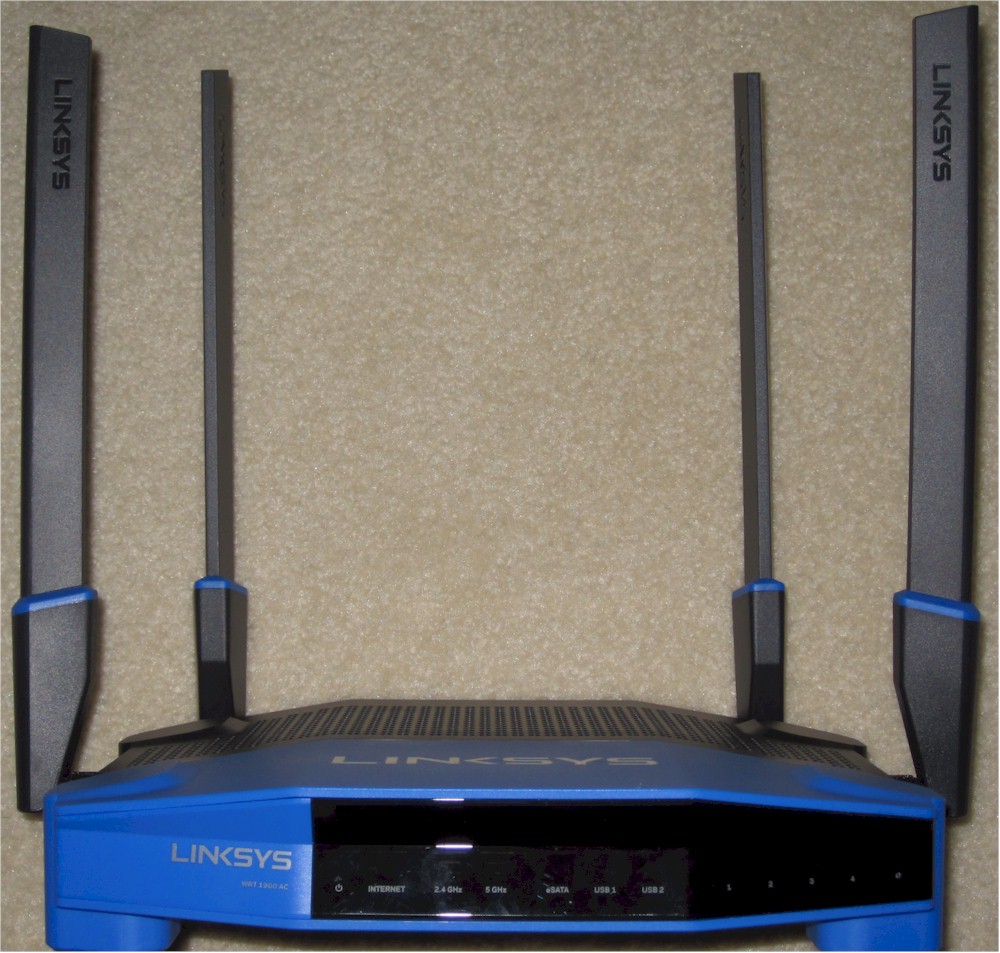
High Gain Antennas on WRT1900AC
The High-Gain uses the common RP-SMA connector found on pretty much all consumer routers and access points that have replaceable antennas. Installation is easy, just screw off the old antennas and screw on the new. I suggest you shut off your router when you do this, so that the router can properly account for the change in gain if it’s capable of doing so.
Performance – Chamber
I decided to test the High Gain antennas in both the test chamber for a comprehensive look over varying signal levels and in open-air at a few test locations for some real-world results. I installed the antennas on a Linksys WRT1900AC (V1) router upgraded to the latest 1.1.9.166760 firmware and tested in both bands, setting the router to our standard Channel 6 and 20 MHz bandwidth for 2.4 GHz and Channel 153 and 80 MHz bandwidth for 5 GHz testing.
I used our Octoscope test chamber and standard wireless router test process, except I was testing the antennas, not the router. I first executed two test runs using the stock antennas. Then shut down the router, swapped in the High Gain antennas, then ran the second set of two runs.
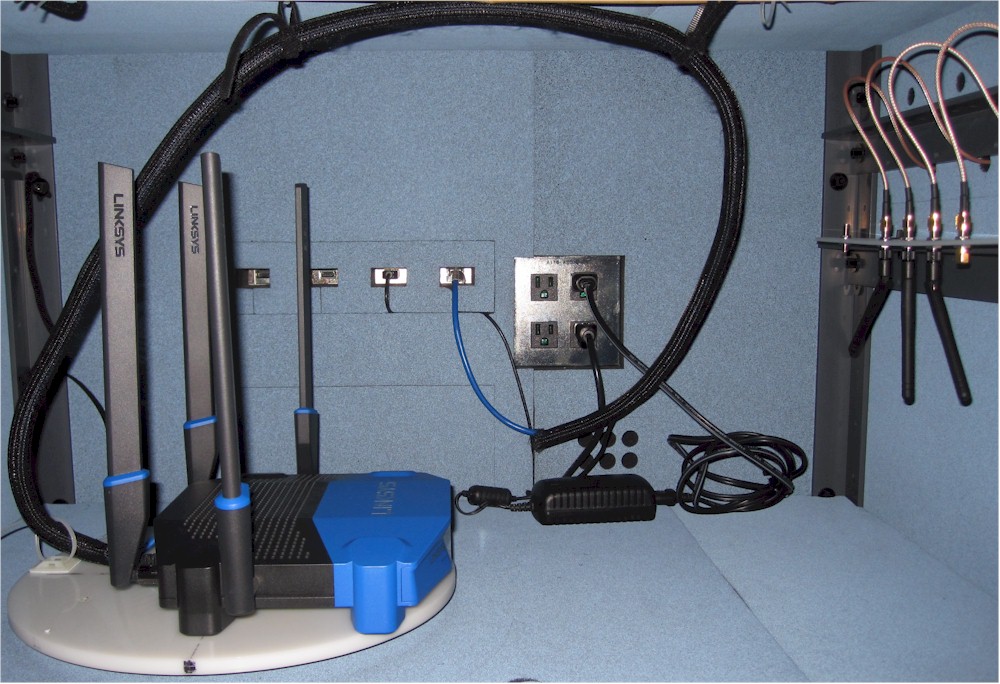
WRT1900AC w/ High Gain Antennas in Test Chamber
The plots below compare the average of the two test runs in each case. 2.4 GHz downlink shows slightly higher throughput in the mid-level signal range and a bit of throughput boost as signal levels drop to the lowest tested levels. The fact that the HighGain test ran to 60 dB attenuation vs. the stock antennas’ 57 dB indicates you might get slightly higher range coverage.
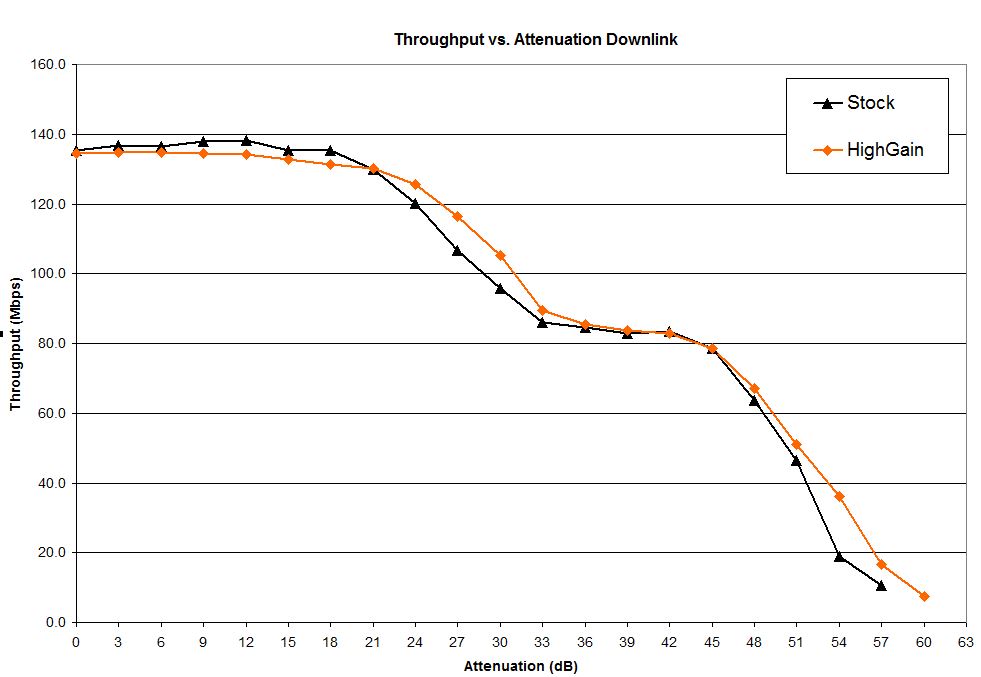
Throughput vs. attenuation comparison – 2.4 GHz downlink
The 2.4 GHz uplink results aren’t as rosy as downlink. The two lines track pretty closely until the HighGain line drops below the stock antennas’ line from 36 to 51 dB. The only positive result in this test is again the extra 3 dB of range.
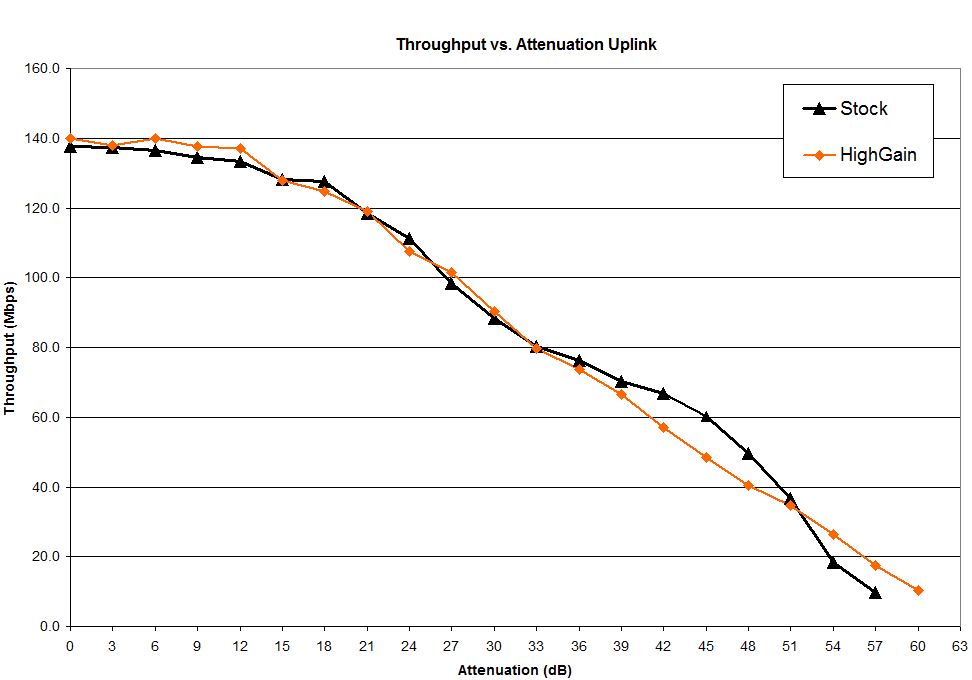
Throughput vs. attenuation comparison – 2.4 GHz uplink
5 GHz results are generally better than 2.4 GHz, which they should be given that band’s higher "up to" 7 dB gain spec. The 5 GHz downlink plot below shows slightly higher throughput for most of the tested range. But the 36 dB end of plot for both stock and HighGain antennas means you are unlikely to extend your 5 GHz coverage footprint.
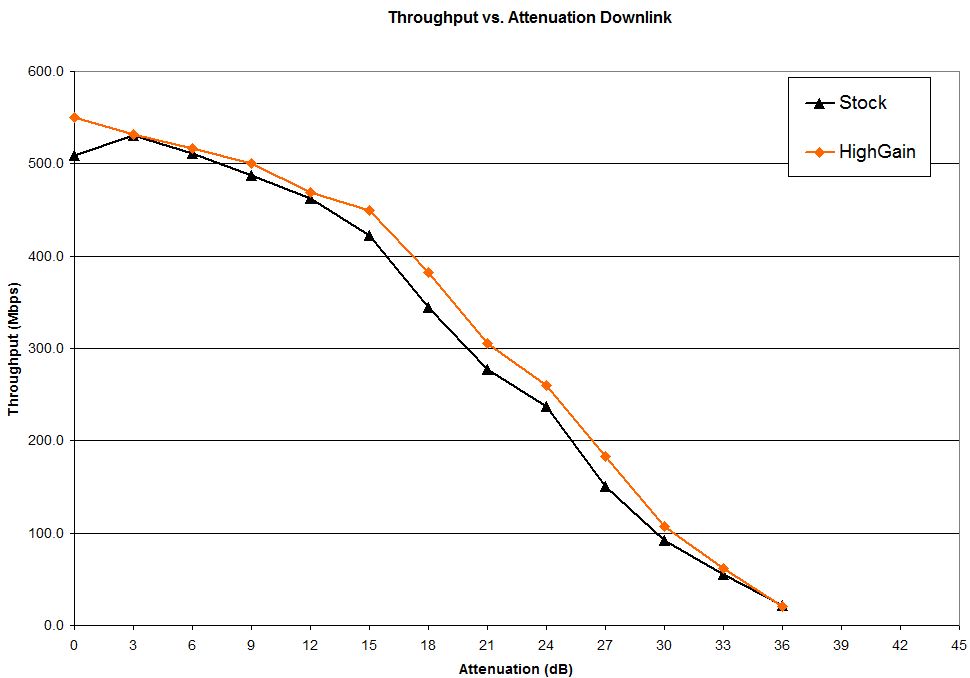
Throughput vs. attenuation comparison – 5 GHz downlink
5 GHz uplink results show a wider separation between stock and HighGain results, which is a good thing. But the same end point for both tests again says there is no coverage footprint improvement here either.
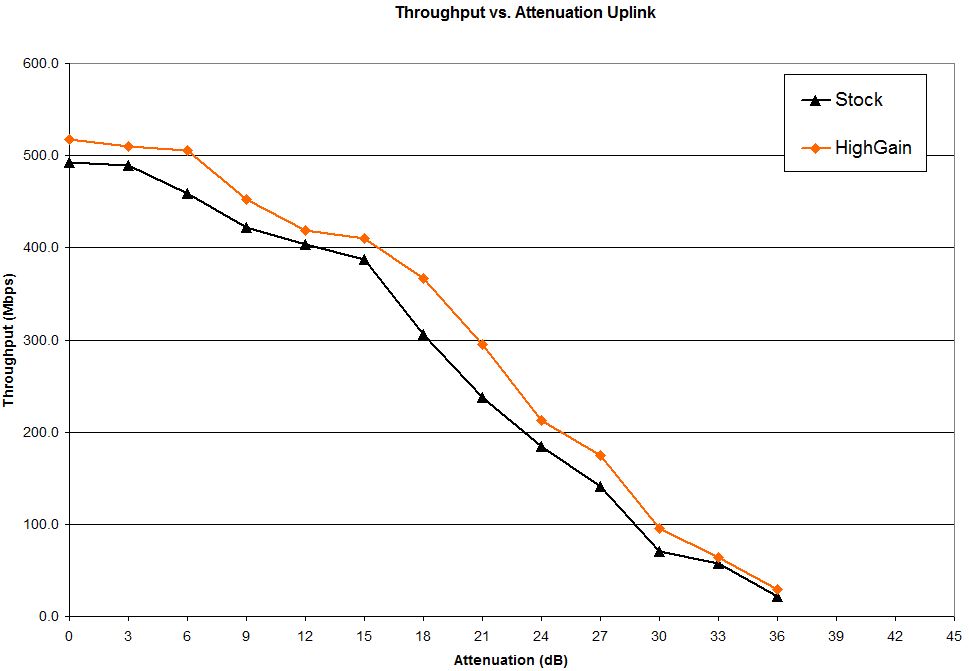
Throughput vs. attenuation comparison – 5 GHz uplink
Performance – Open Air
I initially tested in my old upstairs Location D, with the WRT1900AC in my downstars Location A office. This put the test laptop client in the upper level of my home, approximately 35 feet away (direct path) from the test client with one wood floor, one lower level sheetrock wall and sheetrock ceiling between. I used my trusty Lenovo x220i (Intel Core i3-2310M @ 2.1 GHz, 2 GB RAM) running Win 7 Home Premium SP1 64 bit with a NETGEAR A6200 AC1200 class USB adapter as the test client.
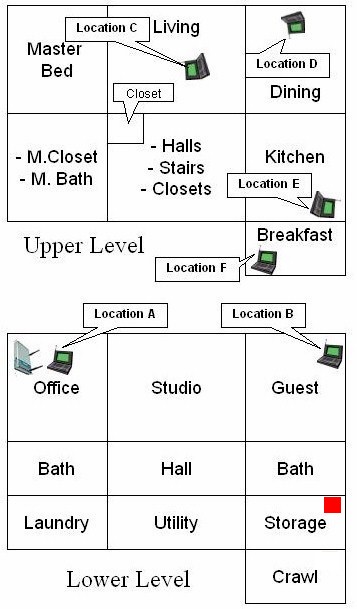
Open Air Test Locations
I ran one uplink and downlink test on both bands in each location first with stock antennas on the WRT1900AC, then the High Gains. I shut down the router when I changed antennas, so that it could account for antenna gain change. I’m not sure the WRT1900AC does this; I just wanted to take that possible variable out of the test.
The results are summarized in the graph below, which is not very impressive. There’s an equal balance of positive and negative results, with the close range Location A turning in the best results in three out of four tests. But we’re buying these things to improve coverage, so Location D is where we want to see the best results.
Unfortunately, three out of four results in Location D are negative, meaning the High Gain antennas produced worse results! Only 2.4 GHz downlink showed better results, albeit a measly 1.6%.
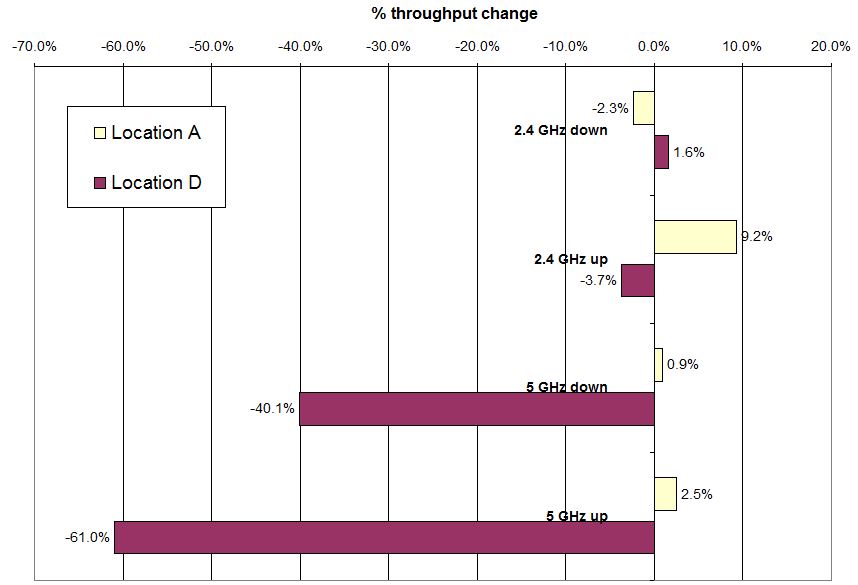
Linksys High Gain Antenna Performance Summary – Locations A, D
However, as I began to write the review, I stumbled upon the beamwidth spec mentioned earlier and these results made sense. The higher 5 GHz gain meant narrower beamwidth, which, even 35 feet away, meant lower signal levels were reaching the test laptop in the upstairs location.
So I added a same-floor test location that, after some experimentation to get a sufficiently low signal level, ended up in the Storage room (red rectangle in the Test Location diagram above). Adding those results to the previous chart changes the picture significantly.
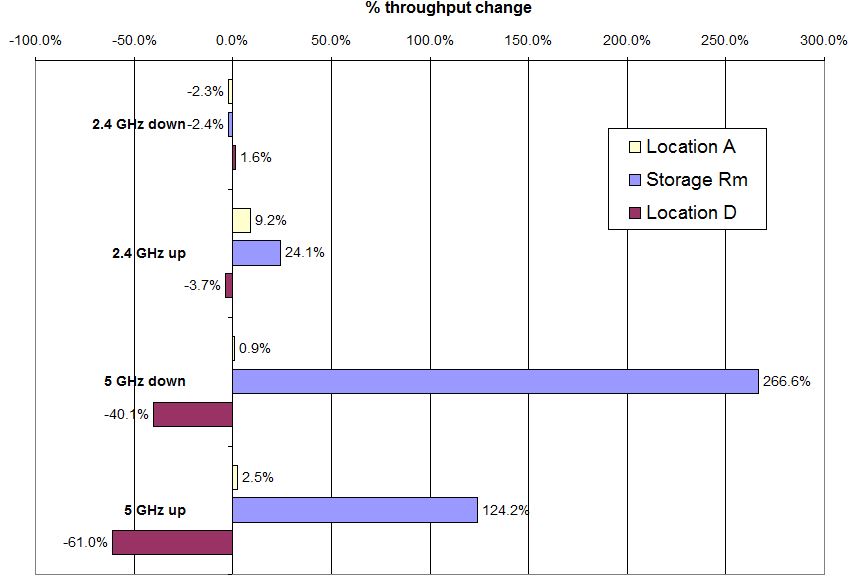
Linksys High Gain Antenna Performance Summary – Locations A, B, D
Now things make more sense. The new same-floor location shows around 3.5 x throughput improvement for downlink (7.7 Mbps to 28 Mbps )and more than 2x improvement for uplink (16.8 Mbps to 37.7 Mbps) for 5 GHz, which has the higher gain. In 2.4 GHz, which has only a moderate gain change of less than 2dB best case, there’s a slight throughput loss in downlink and only 25% gain for uplink.
Closing Thoughts
Switching to higher gain antennas sounds like a no-brainer for easy wireless coverage improvement. But in reality, it’s not so simple. Any gain improvment narrows beamwidth, which affects multi-floor coverage. And without a minimum gain spec, you’re buying a potential pig in a poke.
In the end, if I had $100 to spend on wireless coverage improvement, I’d probably buy an AC class extender like NETGEAR’s AC750 class EX6100 or spend $20 more and try Linksys’ AC1200 class RE6700. Linksys’ High Gain Antennas are just too little bang for too much buck.
